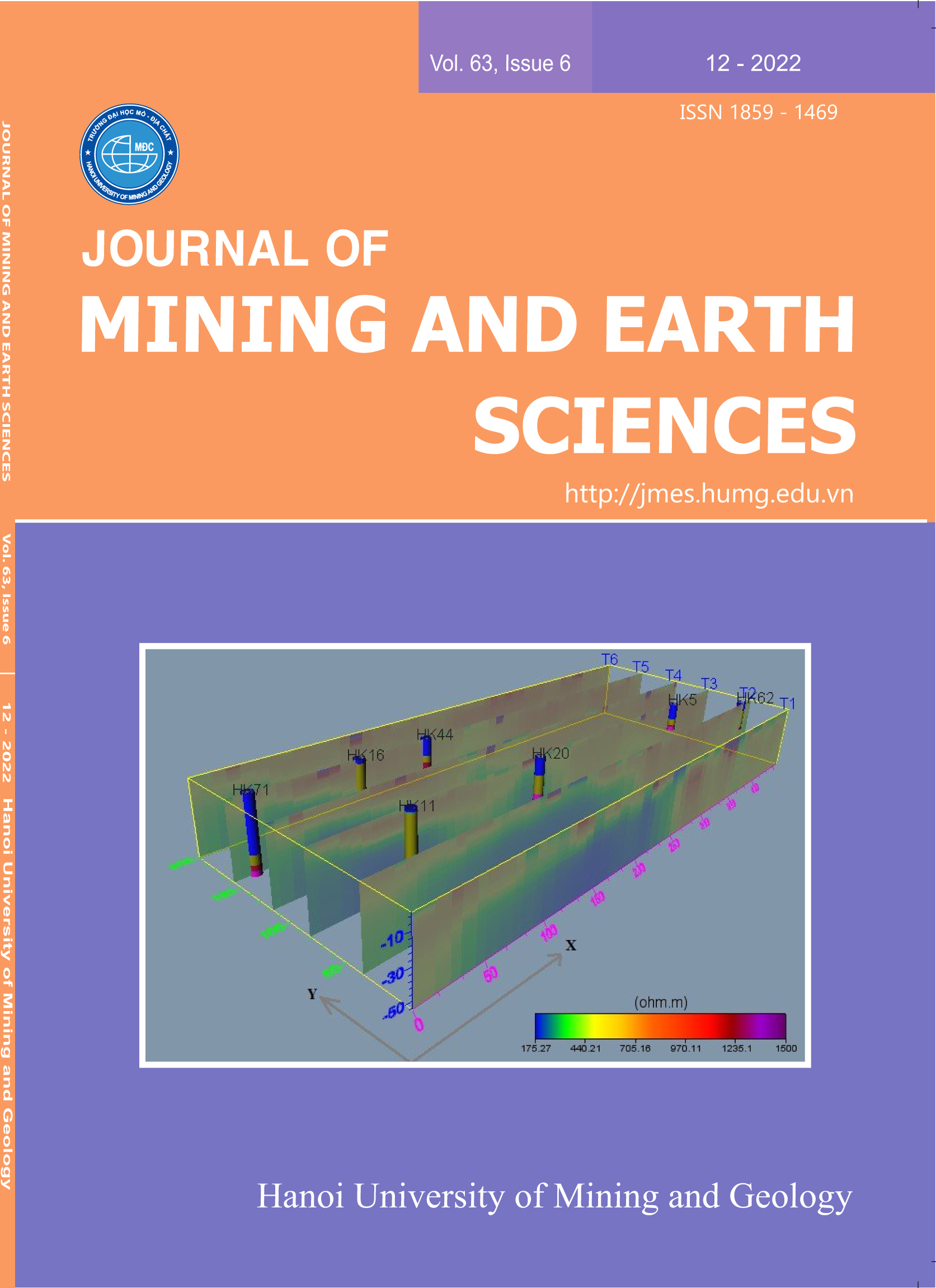3D inversion of 2D electrical resistivity data for geotechnical analysis
Tóm tắt
Geophysical methods are effective tools for geotechnical analysis. In particular, the two-dimensional electrical resistivity method is widely applied in the determination of broken, cracked, and karst cave structures in many countries around the world. The information given by this method plays an important role in preventing and mitigating the risk of geological hazards caused by geological structures. Geotechnical analysis is also an important step in civil construction. However, the interpretation of two-dimensional problems with individual sections still has certain limitations, such as the delineation of the spatial distribution of interesting objects in the entire survey area. We propose a new data processing procedure for the two-dimensional electrical resistivity methods based on rearranging the data as the input of three-dimensional inversion. If the distribution of survey lines is dense enough, we can use two-dimensional data to solve the three-dimensional inverse problems. This inversion will give us a diagram of resistivity distribution in three-dimensional space, which is intuitive and high detail in identifying interesting objects. In this study, the authors have solved the three-dimensional inverse problems from the two-dimensional electrical resistivity survey carried out in the Hoa Lac area, west of Hanoi city. The result shows that the resistivity distribution in three-dimensional space not only increases the intuition but also the accuracy in reflecting the spatial distribution of hidden underground objects. This also defines the localization and determination of fracture zones in the study area as more reliable than explained in each section according to the results of solving two-dimensional inverse problems. The effectiveness of this new method has been proven when compared with drilling results in the studied area.Tài liệu tham khảo
Bui, T. L. (2012). Research and assessment of geological conditions of works serving the construction of high-rise buildings in Quoc Oai district, Hanoi. Master Dissertation.(in Vietnamese).
Doan, V. T., & Vu, C. M. (2008). Accident of karst subsidence and some research results predict dangerous zoning. Proceedings of the National Scientific Conference: "Geological catastrophe and prevention solutions", Hanoi, 153-162.
Duszyński, F., Jancewicz, K., Kasprzak, M., & Migoń, P. (2017). The role of landslides in downslope transport of caprock-derived boulders in sedimentary tablelands, Stołowe Mts, SW Poland. Geomorphology, 295, 84-101.
Le, N. T. (2012). Contribute to determining the cause of erosion on the banks of the Tien River and Saigon River by geophysical surveys near the ground. Journal of Earth Sciences, 34(3), 205-216.
Loke, M.H., & Barker, R.D. (1996). Practical techniques for 3D resistivity surveys and data inversion. Geophysical Prospecting, 44, 499-523.
Loke, M.H. (2010). RES2DINV ver. 3.59. Geoelectrical Imaging 2D&3D. Geotomo software, 148p.
Ogilvy, R., Meldrum, P., Chambers, J., & Williams, G. (2002). The use of 3D electrical resistivity tomography to characterise waste and leachate distribution within a closed landfill, Thriplow, UK. Journal of Environmental & Engineering Geophysics, 7(1), 11-18.
Park, S. (1998). Fluid migration in the vadose zone from 3-D inversion of resistivity monitoring data. Geophysics, 63(1), 41-51.
Pham, N. D., Lai, H. P., Duong, T. N., & Pham, N. K. (2018). Application of electric exploration method to study soil cracking and sinking in Ky Son district - Hoa Binh province. Journal of Science and Technology - Thai Nguyen University, 181(5), 47-53.(in Vietnamese)
Pidlisecky, A., Haber, E., & Knight, R. (2007). RESINVM3D: a 3D resistivity inversion package. Geophysics, 72, H1-H10
Represas, P., Santo, F. M., & Mateus, A.(2005). A case study of two and three‐dimensional inversion of dipole‐dipole data: the Enfermarías Zn‐Pb (Ag, Sb, Au) Prospect (Moura, Portugal). Near Surface Geophysics, 3(1), 21-31.
Soupios, P. M., Georgakopoulos, P., Papadopoulos, N., Saltas, V., Andreadakis, A., Vallianatos, F., & Makris, J. P. (2007). Use of engineering geophysics to investigate a site for a building foundation. Journal of Geophysics and
Engineering, 4(1), 94-103.
Spitzer, K. (1998). The three-dimensional DC sensitivity for surface and subsurface sources. Geophysical Journal International, 134, 736-46.
Sultan, S. A., & Monteiro Santos, F. A. (2008). 1D and 3D resistivity inversions for geotechnical investigation. Journal of Geophysics and Engineering, 5(1), 1-11.
Sultan, S. A., Santos, F. M., & Helal, A. (2006). A study of the groundwater seepage at Hibis Temple using geoelectrical data, Kharga Oasis, Egypt. Near Surface Geophysics, 4(6), 347-354.
Szalai, S., Szokoli, K., Novák, A., Tóth, Á., & Metwaly, M. (2014). Fracture network characterisation of a landslide by electrical resistivity tomography. Natural hazards and earth system sciences, 2(6), 3965-4010.
Weller, A., Frangos, W., & Seichter, M. (2000). Three-dimensional inversion of induced polarization data from simulated waste. Journal of Applied Geophysics, 44(2-3), 67-83.
Yi, M.J., Kim, J.H., Song, Y., Cho, S.J., Chung, S.H. & Suh, J.H. (2001). Three‐dimensional imaging of subsurface structures using resistivity data. Geophysical Prospecting, 49(4), 483-497.
Zhang, J., Mackie, R.L., & Madden, T.R.(1995). 3-D resistivity forward modelling and inversion using conjugate gradients. Geophysics, 60(5), 1313-1325.
Zhao, S.K., & Yedlin, M.J.(1996). Some refinements on the finite-difference method for 3-D dc resistivity modeling. Geophysics, 61(5), 1301-1307.


